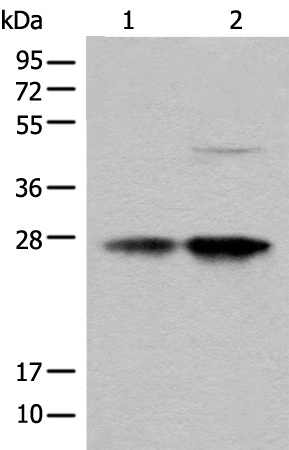COA7 Polyclonal Antibody
Catalog Number
RD218566A
Variation
Quantity
For more information on our kits, please contact us at info@reddotbiotech.com
Overview
Product Name
COA7 Polyclonal Antibody
Catalog Number
RD218566A
Clonality
Polyclonal
Purification Method
Antigen affinity purification
Isotype
IgG
Host
Rabbit
Background
The cytochrome c oxidase (COX) family of proteins function as the final electron donor in the respiratory chain to drive a proton gradient across the inner mitochondrial membrane, ultimately resulting in the production of water. COA7 (cytochrome c oxidase assembly factor 7), also known as RESA1, SELRC1 or C1orf163, is a 231 amino acid mitochondrial protein that belongs to the hcp beta-lactamase family. Consisting of five Sel1-like repeats, COA7 may be associated with respiratory chain assembly. COA7 is encoded by a gene located on human chromosome 1p32.3. Chromosome 1 is the largest human chromosome spanning about 260 million base pairs and making up 8% of the human genome. There are about 3,000 genes on chromosome 1, and considering the great number of genes there are also a large number of diseases associated with chromosome 1. Notably, the rare aging disease Hutchinson-Gilford progeria is associated with the LMNA gene, which encodes lamin A. When defective, the LMNA gene product can build up in the nucleus and cause characteristic nuclear blebs. The mechanism of rapidly enhanced aging is unclear and is a topic of continuing exploration.
Immunogen Information
Immunogen
Full length fusion protein
Swissprot
Q96BR5
Synonyms
beta-lactamase hcp-like proteinC1orf163Chromosome 1 open reading frame 163FLJ12439Hcp beta lactamase like protein C1orf163Hypothetical protein LOC65260RESA1Sel1 repeat containing 1sel1 repeat-containing protein 1
Calculated MW
26 kDa
Observed MW
Refer to figures
Gene Accession
BC015313
Applications
Reactivity
Human, Mouse
Tested Applications
WB,IHC,ELISA
Conjugation
Unconjugated
Dilution
WB 1:500-1:2000, IHC 1:40-1:200, ELISA 1:5000-1:10000
Concentration
0.9 mg/mL
Storage Buffer
PBS with 0.05% NaN3 and 40% Glycerol, pH7.4
Storage Instructions
Store at -20°C. Avoid freeze / thaw cycles.
Research Areas


